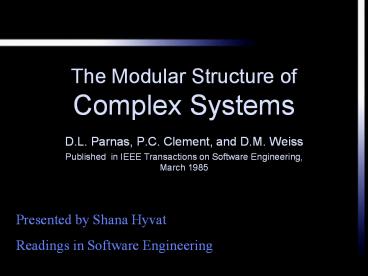The Modular Structure of Complex Systems - PowerPoint PPT Presentation
Title:
The Modular Structure of Complex Systems
Description:
Details that are likely to change become secrets of a particular module, and exist nowhere else ... Utility modules defined by the software designers. Conclusions ... – PowerPoint PPT presentation
Number of Views:115
Avg rating:3.0/5.0
Title: The Modular Structure of Complex Systems
1
The Modular Structure ofComplex Systems
- D.L. Parnas, P.C. Clement, and D.M. Weiss
- Published in IEEE Transactions on Software
Engineering, March 1985
Presented by Shana Hyvat Readings in Software
Engineering
2
Motivation
Software Systems are getting more complex and yet
there exists a growing gap between approaches
presented in theory and implementations in
practice.
3
Possible Reasons for the gap
- Managers will not implement untested principles
- Theoretical examples lack practical relevance
- Theoretical approaches need refinement
- Modular Systems are impractical
- Practitioners are not intellectually capable
4
Valid reasons to address
- Managers will not implement untested principles
- Theoretical examples lack practical relevance
- Theoretical approaches need refinement
- Modular Systems are impractical
- Practitioners are not intellectually capable
5
Implement a Real and Significant Complex System
This is not without challenges, but still will
serve as a model for practical projects.
6
A Sufficiently Challenging Program
- Onboard Flight Program (OFP)for the A-7E
aircraft
- High quality, complex program
- Considered the best of its kind
- Code is complicated and uses many dirty tricks
- Important time and size constraints are barely met
7
Software Structures
Decompositions of the Program
- Module Structure
- like defining objects
- Uses Structure
- like defining objects methods
- Process Structure
- like defining the execution of methods in the
main method
8
Design Principle Model Structure
Decomposition Criterion Information Hiding
- Details that are likely to change become secrets
of a particular module, and exist nowhere else - like private data variables
- Secret information comes out through a module's
access programs - like accessor methods of an object
9
Goals of Modular Structure
- Each module is simple enough to be fully
understood - Change implementation in one module without
affecting other modules - Interfaces must be unlikely to change
- Simultaneous changes to different modules can be
made independently
10
Problems in Modular Structure
- The large number of modules makes it unlikely
that all relevant modules will be known when a
change is necessary - Information hiding works too well engineers
don't necessarily know the inner structure of the
modules and would have to search to find the
right ones to change - It would be easy to miss changing important
modules
11
Tree-Structured Hierarchy
- The hierarchical structure of the module will be
documented in a module guide - A software engineer should understand how to use
the module without knowing its internal
implementation - A reader with well defined concern, should be
able to distinguish relevant components of a
model from irrelevant ones
12
Tree-Structured Hierarchy (continued)
- The number of branches in the tree should be
small enough to help identify dependences in the
tree and to verify that there are no overlapping
responsibilities.
13
Module Description
- Three kinds of information can be used to
describe modules - Its function with respect to the entire system
- The information it keeps secret
- The facilities it provides
- The module guide focuses on secrets, with some
functional description - The module specification provides an in-depth
look at function and facilities
14
A-7E Module Structure Top Level
- Hardware-Hiding Module
- Includes the programs that need to be changed if
any of the hardware is changed - A virtual hardware interface that is used by the
rest of the software - The secrets are the implementation the virtual
hardware
15
A-7E Module Structure Top Level
- Behavior-Hiding Module
- Includes programs that need to be changed if
there are changes in requirements specification
about the behavior
- Software Decision Module
- Modules that don't relate to the hardware or the
requirements - Utility modules defined by the software designers
16
Conclusions
- Running program for the A-7E was not produced
- Authors Observations
- Information hiding in complex systems is
practical when using the module guide - With the model guide new programmers gain a quick
grasp of project - Important to discuss, secrets, roles and
interfaces in the module guide.
17
Conclusions
In addition Clearly many of these principles
exist in what we know today as Object
Oriented. Implementing a complex system may not
prove to produce a final product, but may provide
an environment from which to cultivate models for
real implementations.































